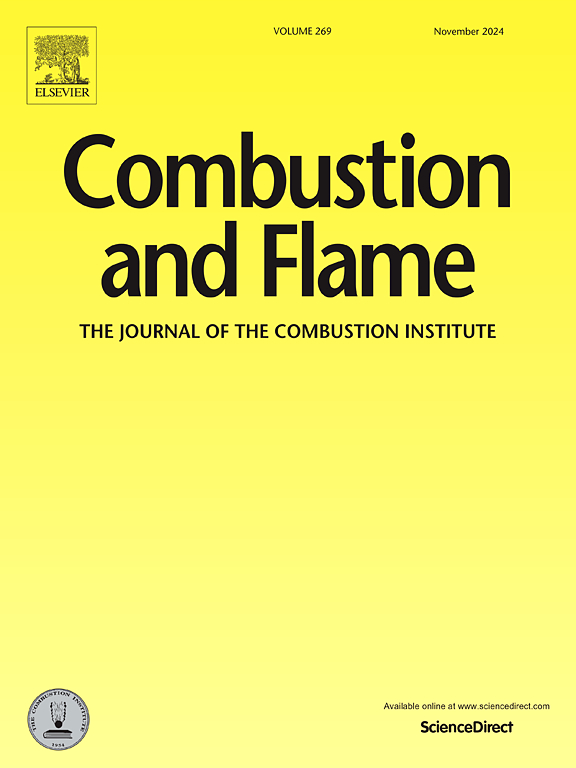Experimental study of butanol droplet combustion in a turbulent, elevated-pressure environment
IF 5.8
2区 工程技术
Q2 ENERGY & FUELS
引用次数: 0
Abstract
To assist in the search for clean liquid alternative fuels for future combustion engines, the combustion characteristics of butanol droplets were experimentally investigated. The experiments were conducted under varying flow turbulence intensity, , (up to m/s), pressure (up to 11 bar), and ambient compositions, including different levels of , , and , at room temperature. A fan-stirred spherical chamber, equipped with four pairs of axial fans, was used to generate a controlled turbulent flow field with negligible mean velocity. A 500 µm butanol droplet was suspended on a single micro-fiber at the center of the chamber and ignited using a coil resistance wire. The combustion process, including the droplet time history and luminous flame structure, was recorded using two synchronized cameras. The findings revealed that increasing ambient pressure enhances the burning rate, , while the effect of turbulence varies with pressure. At low pressure, turbulence has minimal impact, whereas at higher pressure, increases with , before declining due to temporary luminous extinction (TLE). Butanol exhibits a lower than heptane; however, under high-pressure, high-turbulence conditions, their values converge. Additionally, butanol droplet combustion is influenced by and concentrations. Oxygen improves by delaying TLE, while reduces by lowering flame temperature and thermal conductivity of the ambient mixture.
丁醇液滴在湍流高压环境下燃烧的实验研究
为了帮助寻找清洁的液体替代燃料为未来的内燃机,丁醇液滴的燃烧特性进行了实验研究。实验在不同的湍流强度q0.5(高达0.5 m/s)、压力(高达11 bar)和环境成分(包括不同水平的O2、CO2和N2)下进行,并在室温下进行。采用扇形搅拌球室,配置4对轴流风机,产生平均速度可忽略的可控湍流流场。将一个500µm的丁醇液滴悬浮在室中心的一根微纤维上,用线圈电阻丝点燃。利用两台同步摄像机记录了燃烧过程,包括液滴时间历程和发光火焰结构。结果表明,环境压力的增加可以提高燃烧速率Kb,而湍流的影响随压力的变化而变化。在低压下,湍流的影响最小,而在高压下,Kb随着q0.5的增加而增加,然后由于临时发光消光(TLE)而下降。丁醇的Kb值低于庚烷;然而,在高压、高湍流条件下,它们的Kb值收敛。此外,丁醇液滴燃烧受O2和CO2浓度的影响。氧气通过延迟TLE提高Kb,而CO2通过降低火焰温度和周围混合物的导热系数来降低Kb。
本文章由计算机程序翻译,如有差异,请以英文原文为准。
求助全文
约1分钟内获得全文
求助全文
来源期刊

Combustion and Flame
工程技术-工程:化工
CiteScore
9.50
自引率
20.50%
发文量
631
审稿时长
3.8 months
期刊介绍:
The mission of the journal is to publish high quality work from experimental, theoretical, and computational investigations on the fundamentals of combustion phenomena and closely allied matters. While submissions in all pertinent areas are welcomed, past and recent focus of the journal has been on:
Development and validation of reaction kinetics, reduction of reaction mechanisms and modeling of combustion systems, including:
Conventional, alternative and surrogate fuels;
Pollutants;
Particulate and aerosol formation and abatement;
Heterogeneous processes.
Experimental, theoretical, and computational studies of laminar and turbulent combustion phenomena, including:
Premixed and non-premixed flames;
Ignition and extinction phenomena;
Flame propagation;
Flame structure;
Instabilities and swirl;
Flame spread;
Multi-phase reactants.
Advances in diagnostic and computational methods in combustion, including:
Measurement and simulation of scalar and vector properties;
Novel techniques;
State-of-the art applications.
Fundamental investigations of combustion technologies and systems, including:
Internal combustion engines;
Gas turbines;
Small- and large-scale stationary combustion and power generation;
Catalytic combustion;
Combustion synthesis;
Combustion under extreme conditions;
New concepts.
 求助内容:
求助内容: 应助结果提醒方式:
应助结果提醒方式:


